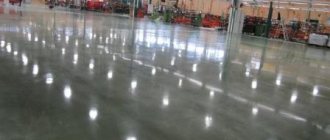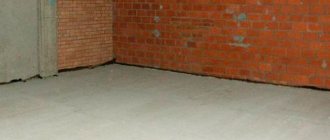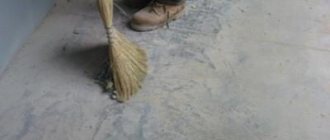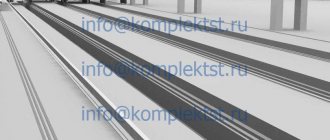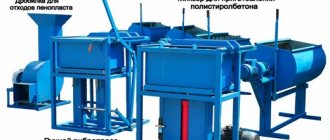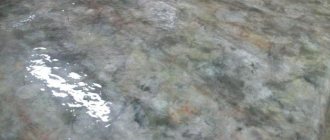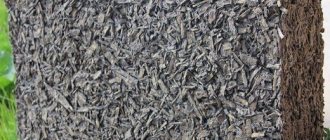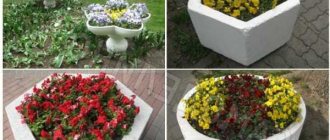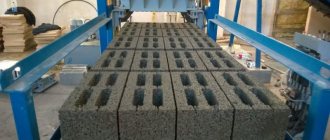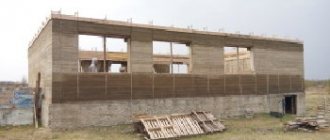Industrial floors are used in various industries, warehouses, and shopping centers.
They are usually made of concrete. The main difference between such floors is their ability to withstand high loads: large traffic flows, movement of heavy equipment, and in some cases, exposure to aggressive environments (water, chemicals). Therefore, they are divided into types depending on their purpose and certain requirements are placed on them.
Types of industrial floors by purpose
Industrial floors are divided into the following types according to their intended purpose:
- for production and warehouse premises, terminals;
- for industrial premises with high (increased) humidity levels;
- for rooms and areas with increased constant load;
- for public institutions (educational, medical, catering organizations);
- for industrial refrigerators and freezers;
- for decontaminated buildings and sanitary checkpoints in the nuclear industry;
- fire- and explosion-proof, antistatic floors;
- polyurethane floors for sports fields.
Design features
To achieve high strength indicators, industrial floors are arranged in several layers. The bottom one is a support
, taking on all the pressure.
Next, if necessary, follows a soundproofing layer
, which also performs the task of heat saving. Its task is to minimize impact noise transmitted to neighboring rooms.
Functional purpose of the waterproofing membrane
— block the destructive effects of moisture.
As a rule, the area of industrial workshops is quite large. It is not always possible to find a roll of such width that it can be rolled out in a straight line in one strip. It is pre-cut into pieces of the required length and overlapped with an overlap of at least 30 cm. Architectural protrusions or communication parts protruding above the surface must be completely treated with waterproofing film
During installation work, it is important to ensure that the waterproofing rises above the layer thickness by 2-3 CM. Subsequently it is cut off. The next layer is a concrete screed, which solves the following problems:
The next layer is concrete screed
, which solves the following problems:
- balances the load on the lower areas;
- levels the surface;
- serves as a platform for the floor itself;
- masks communications.
Primer
will provide good adhesion to the finishing flooring. It is selected depending on the characteristics of the building and the expected level of intensity of operation.
Requirements for industrial floors
Due to the specific nature of the operation of industrial floors, they are subject to special requirements:
- strength;
- wear resistance;
- durability while maintaining qualities important for operation;
- resistance to temperature changes;
- resistance to humidity;
- chemical resistance;
- abrasion resistance;
- tightness;
- no dust;
- fire safety;
- antistatic properties.
Important!
Requirements for industrial floors are regulated by special documentation.
If polymer compositions will be applied
If polymer mixtures are used as the finishing coating, concrete grouting is carried out only with disks (without blades). This will maintain the required roughness. Blade processing will increase the cost of work - it will be necessary to prepare concrete for polymers with much greater labor costs.
In addition to polymer compositions, painting compositions can be used as a finishing coating. Under severe load conditions, acrylic, acrylic-silicone, epoxy and urethane-alkyd enamels work well.
Brief characteristics of each type of coating:
- epoxy compounds are two-component, which requires preparation immediately before starting work. They are easily mixed with a construction mixer and also easily applied to concrete with brushes or rollers. ;
- acrylic - such materials successfully resist moisture and temperature effects and are applied in two layers. The floor is ready for use after 48 hours. A choice of textures is possible: matte, semi-matte, glossy;
- urethane-alkyd – alkyd paints are applied in two working approaches and are characterized by excellent hiding power. Concrete gains resistance to abrasion, beautiful gloss, and long-term operation;
- acrylic-silicone - double application is also practiced here. However, compared to all previous options, this one provides the lowest abrasion resistance. This option can be used to treat areas with light loads.
Epoxy polymer requires preliminary priming, but the finished layer demonstrates high resistance to abrasion loads
Pros and cons of concrete industrial floors
The main advantages of such floors include the following:
- naturalness and high environmental characteristics of concrete, which allows its use in premises of any type of purpose;
- with special treatment, no dust;
- resistance to water and chemicals;
- fire safety;
- resistance to microbial growth;
- strength and durability, allowing concrete floors to be used without repair for 20–30 years.
Important!
All these qualities are ensured only by special treatment of concrete floors. Untreated floors quickly wear out and become dusty under conditions of intensive use.
The following qualities can be considered as disadvantages of concrete floors:
- restrictions in creating decorative effects;
- complex surface preparation before pouring;
- labor-intensive surface removal.
Insulation with mineral wool
Before covering the concrete floor in a house with fiber insulation, it is necessary to prepare the base - it must be clean and dry. Irregularities are removed and depressions are filled. It is necessary to lay a vapor barrier material on the concrete floor, the joints of which can be connected using tape.
On top of the slabs, another layer of hydro- and vapor barrier is laid to prevent the formation of condensation and damage to the insulation.
The installation of a finishing decorative coating in the form of laminate or linoleum is carried out after installing the subfloor in the form of chipboard panels or boards attached to the joists. These materials will serve as additional thermal insulation.
Types of industrial floors by manufacturing method
All industrial floors are made from cement-sand mortars and concrete mixtures, as the most durable and functional materials. However, industrial floors must meet certain requirements, and in order to meet them, certain technologies must be used. An ordinary floor filled with cement-sand mortar without any treatment will not have the necessary qualities, so it will only be suitable for rooms with low cleanliness requirements.
Today, the following technologies exist for installing concrete floors in industrial buildings:
- prefabricated structures made of concrete slabs;
- monolithic concrete slabs;
- cement base.
Cementitious bases are used least often due to their susceptibility to abrasion. The most durable structures are made from slabs, but monolithic slabs are more often used as they do not have seams.
A brief educational program, or What kind of floor screed do you need?
Before raising the question of how to make a floor screed, it is necessary to agree on terms. A screed is usually called a layer of construction mixture laid between the base of the floor and the finishing floor covering. This layer performs such important functions as:
Depending on the composition of the mixture and the installation method, there are several types of screed.
Cement-sand mortar is most often used as a floor leveling material. Industrially produced dry mixes are most common in construction. They are made on the basis of cement and sand with the addition of plasticizers - agents that impart elasticity and plasticity, fiber fiber and other components that improve the properties of the screed.
Depending on the installation method, floor screed can be wet, dry or semi-dry.
The classic method - wet - consists of filling the base with screed mortar and then allowing it to harden.
The mixture is laid directly on the floor slab or on a layer of hydro- or thermal insulation. The last requirement is mandatory when installing the screed directly on the ground (for example, structures like a garden gazebo). A waterproofing layer is necessary for rooms with high humidity (bathhouse, bathroom).
A dry screed is made of sheet material, which is laid on the base on top of an insulating layer (expanded clay, sand, etc.). The advantages of this method are speed and ease of installation, low weight of the structure. The main disadvantages of dry screed are that the sheet material is afraid of water, so it cannot be used in rooms with high humidity, as well as its high cost.
Semi-dry screed can be called an improved version of the wet method. The composition is prepared on the basis of cement-sand mortar with the addition of fiber fiber and plasticizers. When laying, a pneumatic blower is used, which mixes the components and delivers the mixture to the object.
This method is called semi-dry because the additives significantly reduce the moisture content in the solution.
Thanks to this, the screed becomes light, strong, and elastic.
It takes only 12 hours for the solution to dry. After a few days, the final decorative coating can be laid on the screed. This method has, perhaps, only one drawback - the need to use special equipment.
Finishing
An important stage in the installation of an industrial concrete floor is finishing, which allows both to impart special strength to the floor and to create decorative effects (colored, mosaic floors, imitation marble or stone). The installation of industrial concrete floors without additional processing is now rare.
Finishing can be of the following types:
- self-leveling floor;
- coloring;
- application of polymer coating;
- topping.
Let's look at these types of processing.
Self-leveling floor
The floor is filled with an additional layer, which levels it, hides minor defects, providing a smooth surface without seams. The self-leveling floor is very resistant to both abrasion and stress, as well as water and aggressive chemicals, and it can be made aesthetically attractive.
Coloring
This option allows you to achieve the desired decorative effects and obtain floors that meet strict hygienic requirements, but is only suitable for rooms with low mechanical loads.
Application of polymer coating
The polymer coating allows you to give the floor special properties. For example, it can be used for sports fields.
Topping
A modern solution that allows you to get an attractive and at the same time durable, dust-free floor. The technology is that a dry mixture based on Portland cement with fillers and decorative additives (for example, pigments) is applied to the surface of the floor, which has not yet hardened, which allows one to obtain the necessary decorative effects.
Cost of work and materials used
Prices depend on the condition of the concrete base, design concept and total area.
Table 3. Price range
| Name of service or material | Cost (RUB/m²) |
| Removing the old screed | from 350 |
| Waterproofing | from 50 to 200 |
| Self-leveling screed | from 400 to 500 |
| Milling the base | from 80 to 200 |
| Cement strainer | from 150 to 650 |
| Installation of polyurethane flooring | from 150 to 800 |
| Epoxy floor installation | from 200 to 700 |
Prices are current as of 2022.
The cost of installing a self-leveling floor is not considered expensive
Cost of mixtures
An indicator of the quality of any mixture is its composition. Among the large range of products presented on the Russian market, contractors focus consumers’ attention on the following affordable products:
- Fast-hardening universal “Unis-Horizont”. Works on almost any base, both machine and manual. They are used for both uneven surfaces and coatings with slight roughness. Makes the floor durable and smooth. It is possible to apply decorative finishing and install heated floors. The average cost is from 300 rubles per 20 kg.
- Dry mixture “VOLMA-Nivelir Express”. As the leading ingredient of this composition, a complex astringent element, improved with modifiers, is included. It provides excellent workability of the mixture and gives a durable coating. The average cost is from 250 rubles per 20 kg.
- Fast-hardening base leveler "Vetonit-5000". The main area of use is smoothing concrete bases. Also used for screeds. The average cost is from 700 rubles per 25 kg.
- Self-leveling floor "Prospectors". The solution is intended for stabilizing substrates in rooms with moderate humidity. Hardens quickly, perfect for underfloor heating systems. The average cost is from 400 rubles per 25 kg.
- Universal self-leveling mixture Ceresit CN-175. Suitable for weak surfaces. It has good resistance to cracking. Suitable for floating screed devices. The average cost is from 500 rubles per 25 kg.
Despite the relatively low cost of work and materials, companies begin work only upon payment of the minimum order amount. In most cases, it will exceed the minimum required by the customer.
Prices for topping for concrete
topping for concrete
Technology for pouring industrial concrete floors: step-by-step instructions
Work on pouring industrial concrete floors requires the use of special professional equipment:
- concrete pump;
- vibration platforms;
- grinding and concrete finishing equipment.
All work is divided into several stages.
Step 1. Preparatory
Industrial flooring can be laid on the ground or on an old concrete base. Cracks are first expanded and sealed with a cement-sand mixture or polymers, severely damaged areas of the old floor are removed and re-filled. Differences in height are removed with a grinding machine. Then the old floor is primed.
When laying on the ground, it is first analyzed. If necessary, compact the soil. Then a “cushion” consisting of crushed stone and (or) sand, 25 to 40 cm thick, is laid on top and compacted layer by layer. Waterproofing is laid on top of this layer. The formwork is being made.
Step 2. Reinforcement
Industrial floors can be reinforced or non-reinforced. In the first case, a reinforcing mesh is used, which, of course, makes the floor more durable. The installation of a non-reinforced industrial floor is possible if high mechanical loads on the floor are not expected.
Steel reinforcing mesh is laid in one or several layers, its fragments are fastened to each other. This is a rather labor-intensive stage.
A modern solution is the use of so-called volumetric reinforcement, that is, adding polypropylene or basalt fiber, for example, CEMMIX fiber, to the concrete mixture. The effect of using fiber is comparable to using reinforcement, but technologically it is easier to use fiber, there is no need for mesh laying work, and there is no risk of corrosion.
Waterproofing
Waterproofing is an important factor in the safety of industrial flooring. If the pouring is not carried out on the first floor, waterproofing will not be superfluous and will prevent the penetration of moisture downwards, making such a floor the final barrier to any moisture. If the covering is laid on the ground floor or on the ground, the correct installation of waterproofing is the point that determines how many years the floor will serve you.
It's all about the chemical composition of capillary moisture and water vapor that comes from the soil. Such “waters,” depending on the region of the country, have an alkaline or acidic environment. Both options are bad and an active chemical reaction with cement molecules cannot be avoided. The lack of waterproofing will negate all the effort expended and will “kill” the floor in a couple of years.
In this process, polyethylene film (from 200 microns) is usually used. Thermal insulation is laid on top.
Waterproofing
Basalt fiber
Basalt fiber (from roving) is intended for volumetric reinforcement of concrete, mortars and composite materials.
More details
We recommend studying: Increasing the strength of concrete
Step 3. Filling
For pouring industrial floors, concrete of at least B22.5 strength class with entrained air of no more than 3% is used.
Work must be carried out continuously; otherwise it is necessary to arrange seams. Since the areas to be poured are usually large, the concrete mixture is supplied using a concrete pump. The concrete mixture is compacted using vibrators or a vibrating screed.
The use of special additives for concrete, for example, CemThermo CEMMIX additive, makes it possible to save energy and human labor costs.
The CemThermo CEMMIX additive is ideal for floors because it combines the qualities of a plasticizer and a water repellent and provides the concrete mixture with the following properties:
- increased workability;
- increased density and strength of concrete;
- prevention of crack formation;
- increasing the waterproofness of concrete;
- reducing the water requirement of the mixture by 10–20%;
- the ability to save up to 15% of cement without reducing strength.
The additive is supplied ready-made and is easy to dose and introduce into the concrete mixture. Considering that it is very easy to buy CemThermo wholesale from the manufacturer or in retail chains, for example, in Leroy, and the additive itself is inexpensive and is used at the rate of 0.5–1 liters per 100 kg of cement, there are also cost savings. Each liter of CemThermo can save up to 30 kg of cement, which for large-scale work (such as pouring floors) provides noticeable savings.
Preparatory stage
This type of coverage is relevant for any sector of the economy. Due to its practicality and cost-effectiveness, it is confidently gaining popularity in the construction services market. Many industries today prefer it as the cheapest option with excellent performance properties.
Before starting work on installing concrete floors in warehouses and other premises, the site should be prepared. It must be provided with shelter to prevent exposure to precipitation and sunlight. When pouring, gusts of wind are also harmful.
The temperature in the working area should not exceed the permissible limits: from + 10 to + 35 °C. In addition, the site must be provided with power and water supply.
CemThermo
A specialized highly effective plasticizing and strengthening additive for pouring heated floors.
More details
Step 4. Grout
Grouting work performed with special equipment allows you to obtain a flat, smooth, glossy floor surface, increases strength, and eliminates dust. At this stage it is also possible to apply toppings.
Step 5. Varnishing and cutting seams
After polishing is completed, a special polyacrylate varnish is applied to the floor surface, which protects the concrete from drying out and makes the surface more durable.
On the 3rd day, temperature-shrinkage seams are cut to compensate for shrinkage processes. The seams are then sealed with polyurethane sealant.
Industrial floors are an important part of the building. They carry increased loads and must meet high demands. Installing industrial floors is a labor-intensive and large-scale task that requires special equipment and high costs. Saving time, money, labor and at the same time obtaining an industrial concrete floor of the highest quality is a real task if you take advantage of the developments of the modern chemical industry: CemThermo CEMMIX concrete additive and CEMMIX fiber.
You can buy CemThermo, basalt fiber CEMMIX without leaving your home, with discounts from 5 to 33%!!!!
Buy on Ozon
Buy on Yandex.Market
Buy on Wildberries
Buy at Leroy Merlin
Coverage selection criteria
The floors of industrial buildings experience serious stress, but in different ways. Therefore, when choosing a specific type of material, you need to take into account many nuances. Modern technologies make it possible to create flooring materials with good characteristics, but each of them has its own strengths and weaknesses.
What points should be considered when choosing flooring?
- Mechanical loads - from falling tools, technical equipment, cars, warehouse racks;
- Chemical loads – from acids and alkalis, moisture;
- Hygiene – ability to clean, accumulate dust;
- Appearance – glossiness, roughness, texture, color.
The false structure cannot be used in rooms with high humidity. However, it will be indispensable for an office, medical facility, retail space and other public facilities. In turn, topping floors are not decorative enough, but are highly durable, so they are more suitable for service stations, gas stations, parking lots and the woodworking industry. Commercial flooring with high aesthetic values (self-leveling floors) is the best choice for civil premises.
Advantages
Modern industrial floor modular systems are a high-tech floor with a whole range of positive characteristics.
Laying
The modular floor has the advantage of being easy to install. It can be laid on almost all types of substrates. The technology does not require scrupulous preparation and can be implemented without interrupting the production process. This advantage is relevant in areas where downtime leads to serious financial losses.
In addition to the fact that small potholes and cracks in the base cannot affect the performance characteristics of the finished system, a modular floor can be called mobile. The finished surface can be dismantled and installed again, which is in demand in rented areas.
Features of operation
Rubber and PVC tiles are good at eliminating noise interference. In workshops with noisy production processes, this advantage increases productivity. In addition, the coating retains heat well, that is, it acts as additional thermal insulation.
The characteristics of the material are optimally suited for installing floors in rooms where machinery operates with strong vibration, in areas with an unstable climate, and in refrigeration rooms.
Other advantages of industrial modular coatings are:
- the finished coating demonstrates high mechanical and impact strength;
- lack of rigid attachment to the base;
- possibility of local repair;
- safe and most comfortable operation. Correctly selected material can work at temperatures from -40 to +70 degrees;
- wide selection of textures and colors;
- the finished floor is resistant to chemical influences, including electrolytes, alkalis, oils, urea, sea water;
- modules are made from raw materials that do not harm humans during the operation of the coating;
- wide installation possibilities due to different types of locking connections, the possibility of installation with glue;
- noise reduction, sound insulation, which is important in noisy workshops;
- high maintainability – replacement of floorboards is carried out quickly and without extra costs;
- no deformation upon impact;
- strength and wear resistance;
- if the installation technology is followed, a sealed coating is formed that does not allow moisture to pass through;
- thermal insulation;
- possibility of temporary operation;
- Possibility of installing coatings indoors and outdoors.
The range of advantages is limited to several disadvantages. Firstly, both polyvinyl chloride and rubber coatings are afraid of the action of solvents. Modular floors cannot be used in extremely high temperatures.
What is needed for installation
At the preparation stage, the regulatory requirements provided for the type of premises are determined. For production workshops, shockproof or electrical protective properties will be a priority, for warehouses - heat-resistant, for shopping centers and parking lots - the ability to withstand dynamic loads and anti-slip.
They study the base on which industrial floors will be installed. They carry out a leveling survey, determine the horizon and the top point of the base surface and apply markings to the walls, identify large chips and potholes, create a concreting map and work schedule. Surface humidity should not exceed 4% and air humidity 70%. The temperature range is 5-25 degrees, and the adhesion and stability of the result will depend on the conditions under which the work was carried out.
It takes about three weeks, sometimes a month, for the screed to completely set, and about a week for the polymerization of bulk compounds. Employees of the contractor organization must follow safety rules while on site: wear suits, goggles and gloves when working with toxic compounds, and have needle attachments on the soles of their shoes.
Useful tips
Polyurethane paints can be used to mark industrial floors. To do this, a special filler is additionally introduced into the composition (0.3 parts of the volume), which will prevent the composition from flowing under the stencil.
If work is carried out at sub-zero temperatures, check for the presence of frozen water particles in the concrete base, otherwise defects may occur. If during the pouring process small grains of sand or hairs get onto the layer, they are carefully removed with medium-grit sandpaper.
If after polymerization the material comes off as a film, the work technology was violated. The substrate was poorly cleaned or was too wet. For the same reasons, the solution may bubble during the application stage.
